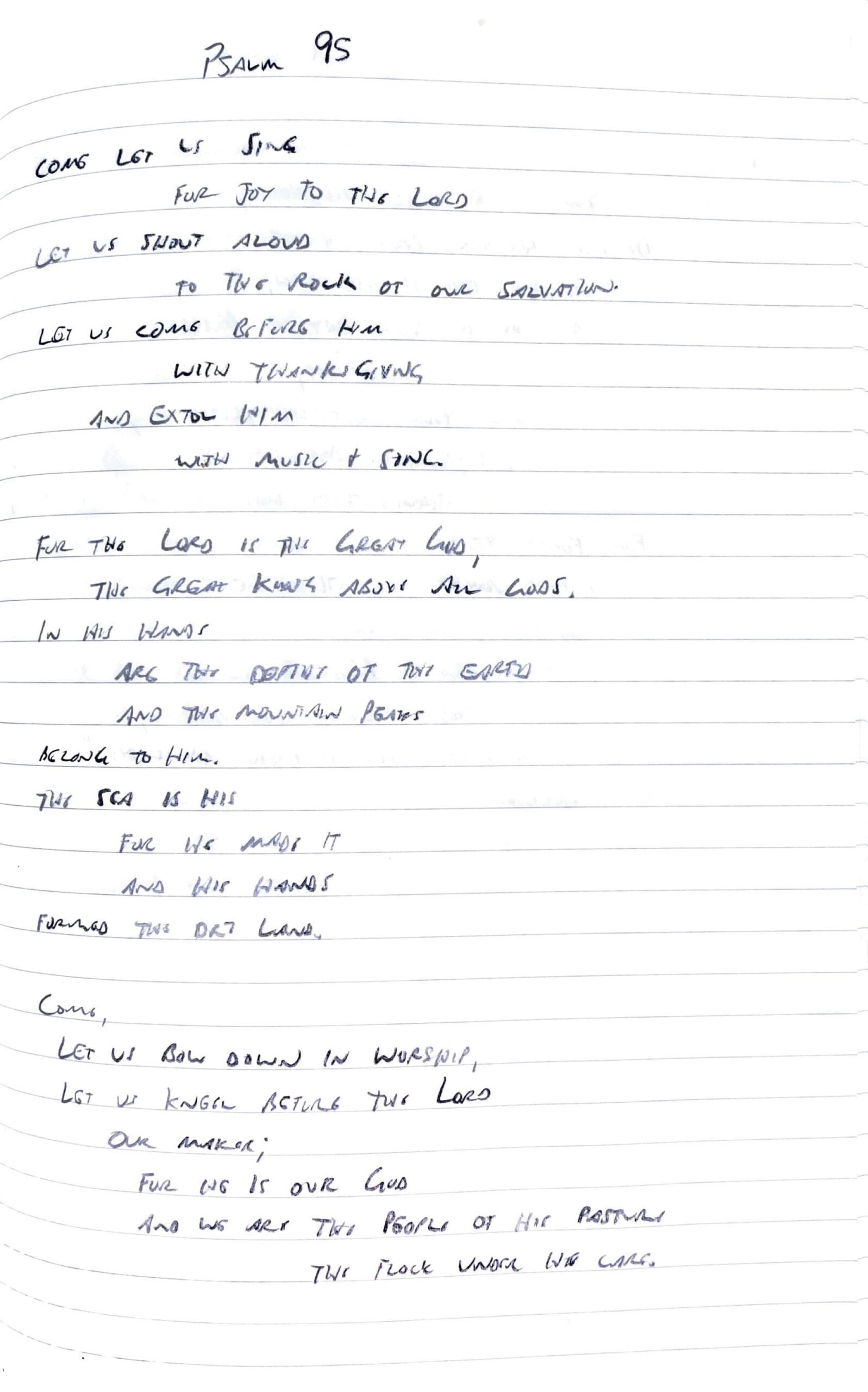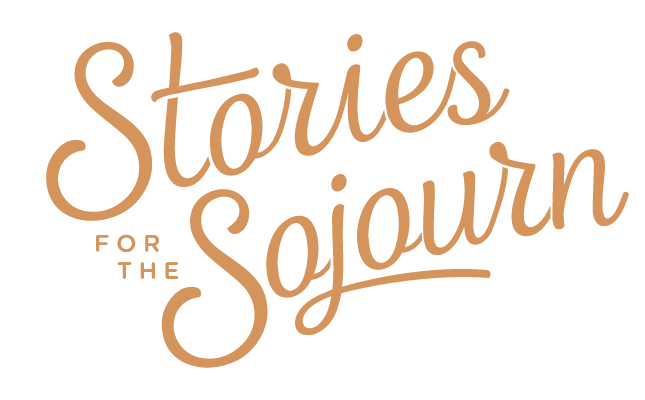Tutorials
Seven Steps
TO LEARN A STORY
. . . . . . . . . . . . . . . . . . .
There are many different ways to internalize a biblical story, and you will need to experiment to learn what works best for you.
In steps below, however, I’ve outlined the process that works best for me.
1. Choose a passage.
Biblical storytelling is a different discipline than memorizing a string of single verses. The real value results from learning larger chunks of scripture: a whole story, a series of connected stories, a whole unit of thought in a letter. The length will vary, of course, depending on the story and your ambition, but strive to learn something that feels complete. If you’re new to this, I would recommend starting with a parable of Jesus. They are short, familiar, memorable stories that can be learned quickly. And, more importantly, they are often challenging or ambiguous enough to reward playful experimentation through performance.
2. Choose a translation.
Before you learn the story, you’ll need to decide what words to learn! There are many good, contemporary translations of the Bible, and you will need to choose the particular translation that works best for your performance setting. If you will be sharing in a church setting, for example, consider which translation your faith community typically uses in corporate worship. Some translations aim for maximum fidelity to the Hebrew or Greek (e.g., ESV, NASB), and that can sometimes detract from their readability (and learnability) in English. Other translations strive for readability (e.g., NIV, CEB), making them more natural to internalize and tell. Whichever translation you choose, make sure that you consult other translations throughout the process. You might discover a word or phrase in another translation that better expresses your growing understanding of the passage. There’s nothing wrong with combining translations and replacing the occasional word or phrase.
You can use Biblegateway.com to explore multiple translations and even set them side-by-side.
3. Copy the passage by hand.
| If you write out the passage, dividing it into thought units on the page and saying the words aloud as you go, you’ll engage visual, auditory, and kinesthetic modes of learning at the same time. It will take some time, but that’s okay. In my experience, by the time I’ve written something out by hand, I’m well on the way to learning it (and may already know a few parts by heart). In the image to the right, see an excerpt from my journal where I copy passages to start learning them. (Pro tip: use a pencil, because you may decide that you want to rearrange the lines after working with them for a while.) |  |
4. Say the passage aloud.
As you move through this process, you will need to get comfortable with hearing your own voice. Read the passage aloud a couple of times to start exploring the sound of the story. (This is the point that friends and family might start looking at you funny if you haven’t found a somewhat private place to learn your passage. It will get worse.)
5. Explore the passage with your voice and body.
Don’t wait until the end to experiment with gestures, tone of voice, facial expressions, pacing, pauses, etc. Sometimes, we think these “performance” choices are the icing on the cake: after doing the hard work of learning the words, then we can add these elements as a last step. Nothing could be further from the truth! Experimenting with these things as you learn the passage will help you internalize it and explore possible meanings. Start working on these elements early in the process. (This is the point when friends and family will definitely start looking at you funny.)
6. Practice, practice, practice.
I’m sorry; there are no shortcuts here. Internalizing a passage requires much more repetition than memorizing one. We barely need to remember the words in order to “recite” a passage; “telling” a passage, on the other hand, depends on a deep understanding of and comfort with the story. Once you memorize the words, you’re well on your way; but you still need to spend more time with the story. And “cramming” is neither efficient nor effective. Reciting a story ten times in a row does far less to ingrain it on your heart than telling it once a day for ten days in a row.
7. Tell the passage to a friend.
Biblical storytelling is a communal way of exploring Scripture (it requires a teller and hearer), and there is no better way to take the final steps toward internalization than telling the passage to another person. It’s an entirely different experience that reciting it to yourself, and you want to get comfortable with the vulnerability it requires. Also, don’t be surprised if you discover new insights into the passage that result from the audience’s reaction to your performance. For example, your friend might laugh when they hear a certain line, highlighting a moment of levity in the story that you had previously missed.
Mobile Apps
FOR LEARNING STORIES
. . . . . . . . . . . . . . . . . . .
The apps below can be helpful tools for learning new stories.
Be warned, however; most “Bible memory” aids aim for memorization instead of internalization.
You’ll still have work to do after using these tools to learn the words.
BIBLE MEMORY
An app that conveniently organizes stories that you are learning, offers tools to help you internalize them, and provides a schedule for reviewing them.
BIBLE HEAD
Another helpful app with different memory tests to help you internalize stories. With this app, you can import passages directly from the various translations available on BibleGatewway.com.
Techniques
FOR DIFFERENT LEARNING STYLES
. . . . . . . . . . . . . . . . . . .

If you are a visual learner, you might find it helpful to write your passage on a blank page so that you can arrange the words in a way that makes them easier for you to remember. Below is a picture of what that might look like for the story of Jesus and the Syrophoenician woman in Mark 7.

You can see how the passage has been divided into “paragraphs” that demarcate the major movements of the story. Also, each line includes a single thought unit, and supporting clauses are indented to indicate their relationship to other parts of the sentence. You don’t need to copy this style of arrangement with your passage. Find something that makes sense to you and helps you see the structure of your passage.
If you are an auditory learner, you might consider repeatedly listening to a recording of your passage. You can find a variety of different audio Bibles available for free at Biblegateway.com. (In the dropdown menus on the landing page, you can choose the version, book, and chapter.) Or, you can use your phone or computer to record yourself reading the passage aloud. Then, you can listen to your own voice as you learn the passage. Once you have a recording you like, listen to it as you work around the house, drive across town, or walk your dog. As you learn the passage, start saying the words along with the recording until you no longer need it.
(If you’re looking for audio versions of the Bible in other languages, check out Bible.is and the related apps for mobile devices.)
If you are a kinesthetic learner, you will want to get your body involved in the process. That might be as simple as walking around as you say the passage aloud to yourself. It will be even more helpful to start practicing the gestures and facial expressions that you will want to use when you tell it to someone else. Often times, those gestures become memory aids. Even if you forget the words, the gesture, facial expression, or other movement will jog your memory and get you back on track.
It’s also helpful to write out by hand the passage that you are studying. We write slower than we type, and taking the time to slowly write out the passage (especially if you divide it into thought or breath units on the page) helps us internalize the passage. Sometimes, after doing this exercise, I find that I’ve already learned significant sections of the story.
HEAR STORIES LIVE
. . . . . . . . . . . . . . . . . . .
I hope you enjoy the performance videos posted on this blog, but the stories are best experienced live!
To hear a story in person, consider bringing me to your church or other organization to share biblical storytelling. I’d enjoy the opportunity to tell stories for a one-time gathering or multi-day event. I’d be even more excited to offer a workshop—ranging from a 30 minute introduction to a weekend retreat—that equips others to tell biblical stories.
SEND A MESSAGE
Have questions? Ask about biblical storytelling and the resources available for you and your group.
BOOK AN EVENT
Already know what you’re looking for? Go ahead and book your storytelling performance or workshop now.
SPEAK TO A PERSON
Call 325.674.3767 to talk directly to someone about this ministry opportunity.



